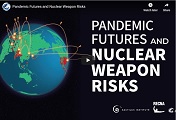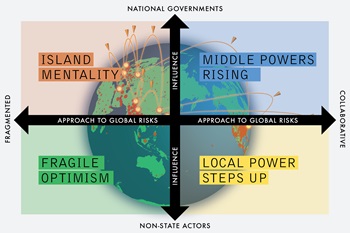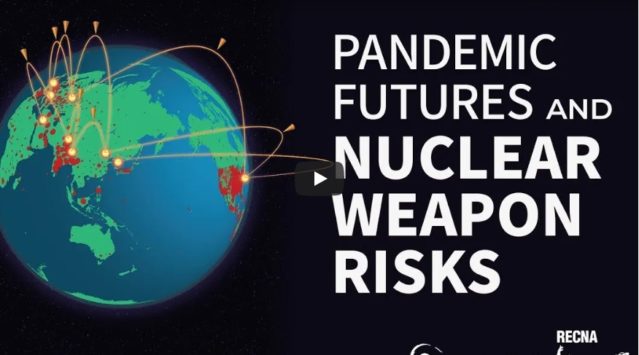PANEL ON PEACE AND SECURITY OF NORTHEAST ASIA (PSNA)
JANUARY 30 2021
The COVID-19 pandemic exposed the failure of nation-states and international institutions to manage global risks and introduced new dynamics—including economic recession, border closures, vaccine competition, and shifts in military behavior—that could heighten the risk of nuclear disaster in the years to come. COVID-19 has already infected three supreme nuclear commanders, has afflicted nuclear command and control organizations, and may ravage nuclear and conventional forces, thereby destabilizing nuclear-prone conflicts at a time when tension should be reduced, not increased. The threat of nuclear war is particularly urgent in the Northeast Asia region, the locus of multiple simmering conflicts.
In this report, the PSNA co-chairs[1] published 19 Recommendations based on the Final Report, downloadable here (PDF file)
Also posted: translations of full-length English report PANDEMIC FUTURES and NUCLEAR WEAPON RISKS:
パンデミックの未来と
核兵器リスク
被爆75年記念事業
「ナガサキ・核とパンデミック・シナリオプロセス」
新型コロナウイルス(COVID-19)パンデミックにより、国家主体や国際機関の世界的リスク管理能力の低さが露呈した。さらに、経済不況、国境閉鎖、ワクチン競争、軍事行動の変化などの新たな動きも生じており、今後数年間で核兵器による大惨事のリスクが高まる可能性もある。核戦争の脅威は、複数の紛争がくすぶっている北東アジア地域では特に喫緊の課題である。コロナ禍の現在、リーダーたちは、「長崎を最後の被爆地に!」という長崎の声を受け止めて、高まる核戦争の脅威を抑えるべく直ちに行動を取らなければならない
핵무기 위험과 팬데믹의 미래
나가사키 원폭 75주년 기념
“팬데믹-핵무기 연계 시나리오” 프로젝트
COVID-19 팬데믹은 국가 및 국제기관의 글로벌 위험 관리상의 비효율성을 드러냈으며, 경제 침체, 국경 폐쇄, 백신 경쟁, 군사 행동의 전환 등 향후 원자력 재해의 위험을 높일 수 있는 새로운 역학을 촉발시켰다. 핵전쟁의 위협은 여러 차례 고조되었던 분쟁의 중심지인 동북아시아 지역에서 특히 시급하다. 오늘날 지도자들은 팬데믹 시대에 증가하고 있는 핵전쟁의 위협을 완화하기 위한 긴급 조치를 취해야 한다. 구체적인 권고는 다음과 같다.
Chinese translation Executive Summary only
COVID-19大流行暴露了国家和国际机构在管理全球风险方面、通报新的动态(诸如经济衰退,边境关闭,疫苗竞争以及军事行动的转变等)的低效率,而这些风险与新的动态极有可能会增加在未来岁月发生核灾难的风险。在东北亚地区的核战争威胁则尤为紧急,因为那里是产生多重冲突的源头。今天的领导人必须采取紧急行动,缓解大流行时代日益增长的核战争威胁,这反映了长崎的声音:“让长崎成为最后!”
This report identifies future scenarios, challenges and opportunities for governments, civil society, and market actors to reduce existential risks, including nuclear risks, in Northeast Asia. The findings are the culmination of a series of scenario planning workshops imagining highly uncertain future conditions and generating a series of “robust actions” that if taken today would ensure that states and societies are better prepared for future risks. Many of the report’s recommendations are drawn from lessons from the pandemic for addressing nuclear threats including constituent engagement, technological solutions, and regional approaches.
The project was co-hosted by the Research Center for Nuclear Weapons Abolition, Nagasaki University (RECNA), the Asia-Pacific Leadership Network for Nuclear Non-proliferation and Disarmament (APLN), and Nautilus Institute, in cooperation with the Nagasaki University Planetary Health Project and the Panel on Peace and Security of Northeast Asia (PSNA).
 A short APLN video of interviews with six participants in Pandemic-Nuclear Nexus Scenarios offers views on scenario planning and why a project such as this is necessary today.
A short APLN video of interviews with six participants in Pandemic-Nuclear Nexus Scenarios offers views on scenario planning and why a project such as this is necessary today.
These documents are published under a 4.0 International Creative Commons License, the terms of which are found here.
The views expressed in this report do not necessarily reflect the official policy or position of the Nautilus Institute. Readers should note that Nautilus seeks a diversity of views and opinions on significant topics in order to identify common ground.
Banner image: Sophia Mauro for Nautilus Institute. This graphic shows the pandemic distribution from the COVID-19 Dashboard by the Center for Systems Science and Engineering (CSSE) at Johns Hopkins University (JHU) as of September 25, 2020; and the two-directional nuclear threat relationships between nuclear-armed states in the form of missile trajectories with re-entry vehicle at the apogees.
II. NAPSNET SPECIAL REPORT BY PANEL ON PEACE AND SECURITY OF NORTHEAST ASIA (PSNA)
LET NAGASAKI BE THE LAST! 19 PANDEMIC-NUCLEAR NEXUS POLICY MEASURES
IN NORTHEAST ASIA
JANUARY 30 2021
Introduction
The COVID-19 pandemic exposed the failure of nation-states and international institutions to manage global risks—including economic recession, border closures, vaccine competition, and shifts in military behavior—that could heighten the risk of nuclear disaster in the years to come. COVID-19 has also introduced new dynamics: it has already infected three supreme nuclear commanders, has afflicted nuclear command and control organizations, and may ravage nuclear and conventional forces, thereby destabilizing nuclear-prone conflicts at a time when tension should be reduced, not increased. The threat of nuclear war is particularly urgent in the Northeast Asia region, the locus of multiple simmering conflicts.
In October-November 2020, RECNA-Nagasaki University and APLN with support of Nautilus Institute convened the Nagasaki 75th Anniversary scenarios workshop to address the pandemic-nuclear nexus.[2] About fifty participants of diverse background explored the future of nuclear war and nuclear disarmament in light of the uncertainty created by the global coronavirus pandemic. Their specific task was to develop four scenarios framed by the relative power of national governments versus non-state actors on the one hand, and fragmented versus collaborative approach to global risk on the other, to answer the focal question:
What are the opportunities driven by global pandemics for Northeast Asian governments, civil society, and market actors to reduce nuclear risk and resume nuclear disarmament?
Four Scenarios

In summary, the four scenarios were:
Middle Powers Rising: National governments are the primary locus of influence, and the approach to global risks is collaborative. The pandemic brings about a new recognition of the critical role of global, multilateral collaboration for dealing with existential risks like pandemics and climate change. “Middle power” countries fill the leadership void left by traditional superpowers.
- Local Powers Step Up: The locus of power and influence shifts toward non-nation-state actors, and the approach to challenges is collaborative. The scenario envisions a new role for local governments and civil society to lead a bottom-up effort to address increasingly dire existential challenges that national governments prove incapable of tackling by themselves.
- Island Mentality: In this scenario, national governments are the primary drivers of influence, but the approach to global risks like pandemics and nuclear deterrence is fragmented. Resurgent nationalism around the world has led to heightened tension and a sense of instability and fear of
- Fragile Optimism: The role of nation-states has diminished and non-state actors—including cities and civil society organizations—have stepped up to fill the gap. But there is a lack of coordination among these groups, and they often find themselves working at cross-purposes.
Nagasaki’s Voice–Nineteen Specific Policy Measures
Reflecting Nagasaki’s voice—Let Nagasaki be the Last! — the workshop recommended sixteen urgent steps that could be implemented globally and in particular, in Northeast Asia, to mitigate the rising threat of nuclear war in the era of pandemics.
- Slowing and reversing nuclear force developments and operations in the Northeast Asia region, including through nuclear-weapon-free zones and nonproliferation treaties
- Developing a secure, reliable nuclear hotline network for communicating in a nuclear crisis
- Launching public health security initiatives in the Northeast Asia region to respond to pandemics, involving regional and global distribution of vaccines in an equitable, rapid and affordable
- Engaging younger generations in the nuclear disarmament movement and mobilizing a broader base of potential stakeholders in nuclear issues
- Enlarging existing city networks such as Mayors for Peace
- Establishing new city/regional cooperation networks to play a more direct role in reducing nuclear risk and pushing for nuclear disarmament
- Solving the DPRK puzzle and denuclearizing the Korean peninsula
- Increasing monitoring, controls and safeguards for the storage and transportation of nuclear materials, including enhanced role for civil society in supporting surveillance and
- Reforming existing global institutions and establishing new programs and initiatives to improve collaboration among nation-states
- Engaging a broader base of nations: Small and middle non-nuclear states should demand more role in nuclear weapons decisions, and expand their say in the UN Security Council and other bodies.
- Supporting international organizations: Governments should invest resources to ensure that critically important international organizations such as the World Health Organization are well- supported and reform them to more
- Taking advantage of the proliferation of apps and sensors for “on-the-ground” information in a nuclear crisis, while ensuring that authorities do not abuse these apps for social and political control
- Developing new platforms for sharing emergency response information and ways to ensure the integrity of this information
- Advocating for budgets: The global economy has been upended by the pandemic. Civil society actors should ensure that national governments allocate sufficient resources to shared global and regional challenges, not nuclear
- Developing new approaches for AI safety and security: Civil society and governments should collaborate to ensure that AI systems are designed for safety and security and cannot be used to hack security systems or worse, catalyze nuclear
- Supporting international scientific cooperation: The sharing of scientific information has been crucial in rapidly advancing treatments and vaccines for the pandemic. The international partnerships and institutions that led to this success—including data-sharing—could serve as a model for other areas, including oversight and reduction of nuclear
Additional policy measures were discussed in the working groups, and the following appear to be also applicable to Northeast Asia although they were not included in the report.
- Promoting microgrid-based regional integration and renewables: It is timely to commence a policy discussion in regional grid integration dialogues that are already taking place, led by China and Mongolia in particular in cooperation with private and public power entities in South Korea and Japan; and to include the DPRK in such discussions in the context of energy assistance provided to facilitate the denuclearization of the Korean peninsula, and the nuclear disarmament of the DPRK in particular, with a focus on bottom-up introduction of micro-grids in each
- Demanding Nuclear Commander Accountability: Nuclear command not be controlled absolutely by one person, but at minimum, involve checks and balances; and all states must assert jurisdiction to hold nuclear commanders to account for threats and use of nuclear weapons based on a new set of norms on behavior and transparency to ensure that manifestly illegal strike orders are never acted on.
- Reinvigorating the Nuclear Non-Proliferation Treaty (NPT): For the NNWS (NPT Non Nuclear Weapon States), there are three issues that need early resurrection: the proposed cut-off of the production of fissionable material; the proclamation of a ‘no first use’ by the NWS (NPT Nuclear
Weapon States) and the other states possessing nuclear weapons; and the further strengthening of the IAEA safeguards and inspections regime, and their application to the NWS. It must be understood that the NWS are not special cases, but rather deviant cases that have failed to honor their obligations under the NPT. Identifying and activating overlapping common interest between the NPT and the TPNW is an important first step to making common cause between nuclear umbrella and nuclear prohibition states in this region.
Reflections on Applicability of the Scenarios and Recommendations to Northeast Asia
Although global, each of the scenarios have special relevance and implications fo the Northeast Asian region, and complement current PSNA policy initiatives.
The Middle Powers Rising scenario, for example, highlights the need to expand the UN Security Council to include more middle-level powers. There are currently no Northeast Asian countries on the Council, and this suggests the need for new strategies and initiatives to expand or ensure regional Northeast Asian membership of the Council, particularly in view of its critical role in dealing with regional crises in a timely way.
The Local Powers Step Up scenario envisions how cities and provinces develop new communication structures and platforms for city and regional leaders to share best practice on various ways to meet the new existential risks, whether pandemics, climate change or nuclear war—a potent strategy for cities such as Nagasaki and Seoul to undertake in partnership, especially if they make common cause with non-state actors such as companies and civil society to practice civic diplomacy for nuclear disarmament.
The Fragile Optimism scenario identifies the need to explore new opportunities outside of direct government roles for ways of softening ties with North Korea—which may be critically important in the post-Trump era. More specifically, in the case of North Korean proliferation, the Scenarios Report identified the need for civil society actors, including cities and regional governments in South Korea and other Northeast Asian regions, to play a greater role in fostering negotiations with North Korea, particularly through new initiatives and incentives, both economic and cross-cultural. This is a level of action that PSNA could seek to advocate, particularly in the context of pursuing a regional Northeast Asian nuclear-weapon-free zone.
Although women constituted more than fifty percent of the participants in the scenarios workshop, there were no specific recommendations concerning gender.[3] All of these scenarios present an urgent need to elevate the role of women and to increase cultural and generational diversity into decision- making at all levels.
Comprehensive Security
PSNA was created to advocate for a concept of comprehensive security in Northeast Asia. In this vein, the Report suggested nuclear-free-zones, and nuclear-disarmament norm-setting as exemplified in the UN Treaty on the Prohibition of Nuclear Weapons. PSNA might take these specific goals and push regional governments to jointly convene a regional conference to discuss and create a consensus at many levels on the need for a comprehensive security agreement for Northeast Asia, initiate a regional nuclear-weapon-free zone, and explore regional roles in implementing the new UN Treaty on the Prohibition of Nuclear Weapons.
The Island Mentality scenario–perhaps one of the more plausible of scenarios arising from the Trump era of hyper-nationalism and opposition to multilateralism, prompted a number of strategies aimed at assisting nations to manage and successfully address multiple simultaneous crises, especially in the case of pandemics and refugees from war and climate change.
A comprehensive security regional framework is essential to undertake such a task in a systematic manner, perhaps under the umbrella concept of “planetary health.” To this end, a regional public health security initiative led by regional cities and first responders might be an effective way to initiate a comprehensive security institutional framework in this region, and might be an agenda that PSNA, in partnership with other networks in the region, might pursue.
Nuclear Hotline and a Regional Summit: Let Nagasaki be the Last!
The Scenarios Workshop, and some of the discussion papers that informed the Workshop, drew detailed attention to the threats of accidental, miscalculate or pre-emptive war as tensions between China and the United States and other states in the region increase and nuclear weapon states modernize their nuclear weaponry to include new forms of tactical weapons, and command and control systems that greatly reduce response times in nuclear crises. As noted earlier, during pandemics, nuclear commanders might become incapacitated through infection or have their judgment affected. As the Workshop Report highlights, nuclear hotlines become vital in such circumstances if inadvertent nuclear war is to be averted. Given past and incipient tensions within Northeast Asia, both on the Korean Peninsula and in relation to Taiwan, and rapidly evolving nuclear weapon systems, establishment of such hotlines are needed as a matter of great urgency. Advocating nuclear hotlines with each government in the region could be an important PSNA priority.
Of critical importance, the Report specifically called for slowing and reversing nuclear force deployments and operations in Northeast Asia as a policy step that could be taken not only by nuclear prohibition states but also regional states allied to nuclear weapon states. Irrespective of alliance relationships, it should be in all states’ interests to reduce the risks of nuclear war arising out of regional conflicts and crises. A summit at which leaders would declare that nuclear weapon would never be used again in this region would be an important first step to reverse this dangerous dynamic by declaring Let Nagasaki be the last! as a precursor to adoption of a regional No-First Use common policy by the nuclear-armed states in this region.
III. ENDNOTES
[1] Co-Chairs of PSNA are: Prof. Michael Hamel-Green, Dr. Peter Hayes, Dr. Yongsoo Hwang, Dr. Angela Kane, Prof. Chung-in Moon, Dr. Masao Tomonaga, Prof. Frank von Hippel. For more information about PSNA see https://www.recna.nagasaki-u.ac.jp/recna/psna
[2] The full report of the workshop is RECNA-Nagasaki University, Asia Pacific Leadership Network, Nautilus Institute, “PANDEMIC FUTURES and NUCLEAR WEAPON RISKS”, posted December 16, 2020 by RECNA here, APLN here, and by Nautilus Institute here. The fifteen supporting expert papers on a variety of nexi between pandemics and nuclear risk and disarmament are listed in Appendix 1.
[3] 51% woman, 49% men, overall. This silence may be explained by a masculinist style still prevalent in deliberations of the working groups; or, how the narratives themselves were shaped by women in ways that expressed how these issues are gendered—or both.
IV. NAUTILUS INSTITUTE INVITES YOUR RESPONSE
Nautilus Institute invites your responses to this report. Please send responses to: nautilus@nautilus.org Responses will be considered for redistribution to the network only if they include the author’s name, affiliation, and explicit consent.


